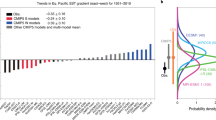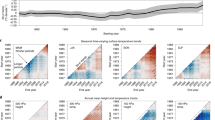Abstract
Despite the continued increase in atmospheric greenhouse gas concentrations, the annual-mean global temperature has not risen in the twenty-first century1,2, challenging the prevailing view that anthropogenic forcing causes climate warming. Various mechanisms have been proposed for this hiatus in global warming3,4,5,6, but their relative importance has not been quantified, hampering observational estimates of climate sensitivity. Here we show that accounting for recent cooling in the eastern equatorial Pacific reconciles climate simulations and observations. We present a novel method of uncovering mechanisms for global temperature change by prescribing, in addition to radiative forcing, the observed history of sea surface temperature over the central to eastern tropical Pacific in a climate model. Although the surface temperature prescription is limited to only 8.2% of the global surface, our model reproduces the annual-mean global temperature remarkably well with correlation coefficient r = 0.97 for 1970–2012 (which includes the current hiatus and a period of accelerated global warming). Moreover, our simulation captures major seasonal and regional characteristics of the hiatus, including the intensified Walker circulation, the winter cooling in northwestern North America and the prolonged drought in the southern USA. Our results show that the current hiatus is part of natural climate variability, tied specifically to a La-Niña-like decadal cooling. Although similar decadal hiatus events may occur in the future, the multi-decadal warming trend is very likely to continue with greenhouse gas increase.
This is a preview of subscription content, access via your institution
Access options
Subscribe to this journal
Receive 51 print issues and online access
$199.00 per year
only $3.90 per issue
Buy this article
- Purchase on Springer Link
- Instant access to full article PDF
Prices may be subject to local taxes which are calculated during checkout



Similar content being viewed by others
References
Easterling, D. R. & Wehner, M. F. Is the climate warming or cooling? Geophys. Res. Lett. 36, L08706 (2009)
Foster, G. & Rahmstorf, S. Global temperature evolution 1979–2010. Environ. Res. Lett. 6, 044022 (2011)
Solomon, S. et al. Contributions of stratospheric water vapor to decadal changes in the rate of global warming. Science 327, 1219–1223 (2010)
Solomon, S. et al. The persistently variable “background” stratospheric aerosol layer and global climate change. Science 333, 866–870 (2011)
Kaufmann, R. K., Kauppi, H., Mann, M. L. & Stock, J. H. Reconciling anthropogenic climate change with observed temperature 1998–2008. Proc. Natl Acad. Sci. USA 108, 11790–11793 (2011)
Meehl, G. A., Arblaster, J. M., Fasullo, J. T., Hu, A. & Trenberth, K. E. Model-based evidence of deep-ocean heat uptake during surface-temperature hiatus periods. Nature Clim. Change 1, 360–364 (2011)
Meehl, G. A. et al. in Climate Change 2007: The Physical Science Basis (eds Solomon, S. et al.). 747–845 (Cambridge University Press, 2007)
Delworth, T. L. et al. GFDL's CM2 global coupled climate models. Part I: Formulation and simulation characteristics. J. Clim. 19, 643–674 (2006)
Zhang, Y., Wallace, J. M. & Battisti, D. S. ENSO-like interdecadal variability: 1900–93. J. Clim. 10, 1004–1020 (1997)
Meehl, G. A., Hu, A., Arblaster, J., Fasullo, J. & Trenberth, K. E. Externally forced and internally generated decadal climate variability associated with the Interdecadal Pacific Oscillation. J. Clim. http://dx.doi.org/10.1175/JCLI-D-12-00548.1. (2013)
Alexander, M. A. et al. The atmospheric bridge: the influence of ENSO teleconnections on air-sea interaction over the global oceans. J. Clim. 15, 2205–2231 (2002)
Lau, N.-C. & Nath, M. J. The role of the ''atmospheric bridge'' in linking tropical Pacific ENSO events to extratropical SST anomalies. J. Clim. 9, 2036–2057 (1996)
Cohen, J. L., Furtado, J. C., Barlow, M., Alexeev, V. A. & Cherry, J. E. Asymmetric seasonal temperature trends. Geophys. Res. Lett. 39, L04705 (2012)
Trenberth, K. E., Caron, J. M., Stepaniak, D. P. & Worley, S. Evolution of El Niño-Southern Oscillation and global atmospheric surface temperatures. J. Geophys. Res. 107, AAC 5-1–17. http://dx.doi.org/10.1029/2000JD000298 (2002)
Vecchi, G. A. et al. Weakening of tropical Pacific atmospheric circulation due to anthropogenic forcing. Nature 441, 73–76 (2006)
Barriopedro, D., García-Herrera, R., Lupo, A. R. & Hernández, E. A climatology of northern hemisphere blocking. J. Clim. 19, 1042–1063 (2006)
Hoerling, M. et al. Anatomy of an extreme event. J. Clim. 26, 2811–2832 (2013)
Wang, H. et al. Attribution of the seasonality and regionality in climate trends over the United States during 1950–2000. J. Clim. 22, 2571–2590 (2009)
Deser, C., Knutti, R., Solomon, S. & Phillips, A. S. Communication of the role of natural variability in future North American climate. Nature Clim. Change 2, 775–779 (2012)
Tokinaga, H., Xie, S.-P., Deser, C., Kosaka, Y. & Okumura, Y. M. Slowdown of the Walker circulation driven by tropical Indo-Pacific warming. Nature 491, 439–443 (2012)
DiNezio, P. N. et al. Climate response of the equatorial Pacific to global warming. J. Clim. 22, 4873–4892 (2009)
Ma, J. & Xie, S.-P. Regional patterns of sea surface temperature change: a source of uncertainty in future projections of precipitation and atmospheric circulation. J. Clim. 26, 2482–2501 (2013)
Morice, C. P., Kennedy, J. J., Rayner, N. A. & Jones, P. D. Quantifying uncertainties in global and regional temperature change using an ensemble of observational estimates: the HadCRUT4 data set. J. Geophys. Res. 117, D08101 (2012)
Allan, R. & Ansell, T. A new globally complete monthly historical gridded mean sea level pressure dataset (HadSLP2): 1850–2004. J. Clim. 19, 5816–5842 (2006)
Adler, R. F. et al. The version-2 global precipitation climatology project (GPCP) monthly precipitation analysis (1979-present). J. Hydrometeorol. 4, 1147–1167 (2003)
Taylor, K. E., Stouffer, R. J. & Meehl, G. A. An overview of CMIP5 and the experiment design. Bull. Am. Meteorol. Soc. 93, 485–498 (2012)
Rayner, N. A. et al. Global analyses of sea surface temperature, sea ice, and night marine air temperature since the late nineteenth century. J. Geophys. Res. 108, 4407 (2003)
Sen, P. K. Estimates of the regression coefficient based on Kendall’s tau. J. Am. Stat. Assoc. 63, 1379–1389 (1968)
Trenberth, K. E. Signal versus noise in the Southern Oscillation. Mon. Weath. Rev. 112, 326–332 (1984)
Fetterer, F. & Knowles, K. Sea ice index monitors polar ice extent. Trans. AGU 85, 163 (2004)
Acknowledgements
We thank the Geophysical Fluid Dynamics Laboratory model developers for making the coupled model version 2.1 available and L. Xu, Y. Du, N. C. Johnson and C. Deser for discussions. The work was supported by the NSF (ATM-0854365), the National Basic Research Program of China (2012CB955600), and NOAA (NA10OAR4310250).
Author information
Authors and Affiliations
Contributions
Y.K. and S.-P.X. designed the model experiments. Y.K. performed the experiments and analysis. S.-P.X. and Y.K. wrote the manuscript.
Corresponding author
Ethics declarations
Competing interests
The authors declare no competing financial interests.
Extended data figures and tables
Extended Data Figure 1 Observed climate indices for the recent decade.
From top to bottom are shown the annual-mean global near-surface temperature anomalies from the 1980–1999 average, the DJF Southern Oscillation Index (SOI), the DJF SLP near the Aleutian Islands (40°–60° N, 170°–120° W), the JJA SAT over the southern USA (30°–45° N, 110°–80° W), and the September (Sep) Arctic sea ice extent.
Extended Data Figure 2 11-year trends of annual-mean SAT composited for 34 hiatus events in HIST.
The hiatus events are chosen for which annual-mean global SAT trends are smaller than their ensemble mean minus 0.3 °C per 11 years. Stippling indicates 95% statistical confidence. Note that a typical hiatus in HIST features a La-Niña-like pattern in the tropics and SST cooling around the Aleutian Islands, patterns similar to the current hiatus event.
Extended Data Figure 3 Net radiative imbalance and ocean heat content increase in POGA-H and HIST.
a, b, Net radiative imbalance at the top of the atmosphere. Positive values indicate net energy flux into the planet. c, d, Ocean heat content deviations from 1950 values for each ensemble member. POGA-H (a and c) and HIST (b and d). Shading represents the 95% confidence interval of ensemble means. Major volcanic eruptions are indicated. The radiative imbalance has remained positive and ocean heat content has kept increasing for the recent decade in both of the experiments. We note that the energy budget is not closed in POGA-H.
Extended Data Figure 4 Seasonal dependency of regional temperature trends.
a, b, Observed temperature anomalies (solid) and their trends (dashed) for the recent decade (°C). c, d, Probability density functions (curves) and means (vertical lines) of 11-year SAT trends in HIST for 1971–2040. Temperature has been averaged over the tropics (20° S–20° N; panels a and c) and the northern extratropics (20°–90° N; panels b and d) for JJA (red) and DJF (blue). Note that the northern extratropics features a larger probability density function spread in winter than summer, in contrast to a high similarity in the tropics. The winter spread is also greater in the extratropics than the tropics, whereas the opposite is true for summer.
Extended Data Figure 5 Decadal anomalies associated with SST cooling over the equatorial Pacific.
Low-pass-filtered intermember anomalies in HIST regressed against SST anomalies over the area denoted by 5° S–5° N and 170° E–130° W (white boxes in a and b). a, b, SAT; c, d, SLP; e, f, Precipitation for DJF (a, c, e) and JJA (b, d, f). The sign is flipped to show a La Niña state. Stippling indicates 95% statistical confidence. We note that cold anomalies spread to the Arctic region in boreal winter but are restricted south of 60° N in summer. Anomalies in the tropics, the North Pacific and North America are broadly consistent with the trends for the current hiatus.
Extended Data Figure 6 Observed and simulated trend patterns in boreal summer for the accelerated global warming period.
Temperature (a and b) and precipitation (c and d) from observations (a and c) and POGA-H (b and d) in JJA. a, b and d, Trends for 1971–1997. c, The trend is evaluated for 1979–1997 and scaled to 27-year change. Stippling indicates 95% statistical confidence. Purple boxes in b show the restoring region of POGA experiments. We note the widespread warming, with weak cooling in the North and South Pacific oceans and a weakened Walker circulation. POGA-H reproduces the warming hole18 (warming minimum or cooling in the central USA) with slight geographical displacements due to model biases.
Extended Data Figure 7 Internal decadal variability in SST.
Standard deviations of annual-mean SST from observations27 detrended for 1900-2012 (a) and from inter-member anomalies in HIST (b). Data were evaluated with a decadal low-pass filter. We note that tropical variance is most pronounced in the Pacific.
Rights and permissions
About this article
Cite this article
Kosaka, Y., Xie, SP. Recent global-warming hiatus tied to equatorial Pacific surface cooling. Nature 501, 403–407 (2013). https://doi.org/10.1038/nature12534
Received:
Accepted:
Published:
Issue Date:
DOI: https://doi.org/10.1038/nature12534
This article is cited by
-
Contributions of external forcing and internal variability to the multidecadal warming rate of East Asia in the present and future climate
npj Climate and Atmospheric Science (2024)
-
Intensification of Pacific tropical instability waves over the recent three decades
Nature Climate Change (2024)
-
Increasing tropical cyclone intensity in the western North Pacific partly driven by warming Tibetan Plateau
Nature Communications (2024)
-
Mechanisms and impacts of enhanced rainfall over large islands in the Maritime Continent during the mid-holocene
Climate Dynamics (2024)
-
Responses of the Pacific and Atlantic decadal variabilities under global warming by using CMIP6 models
Ocean Dynamics (2024)
Comments
By submitting a comment you agree to abide by our Terms and Community Guidelines. If you find something abusive or that does not comply with our terms or guidelines please flag it as inappropriate.



